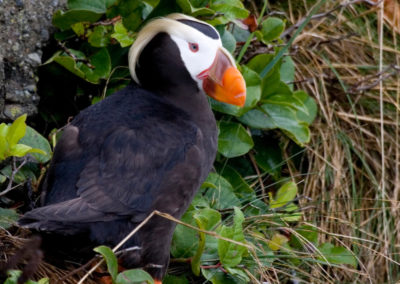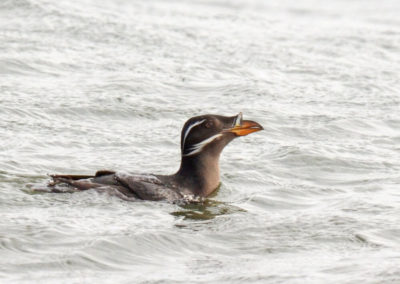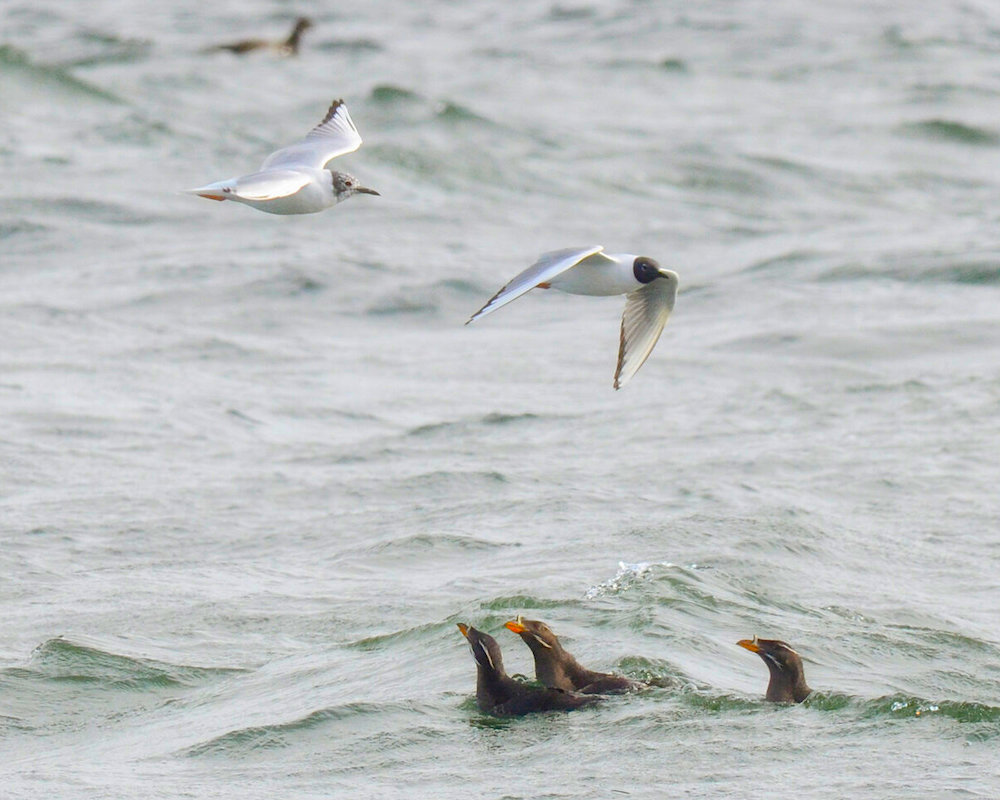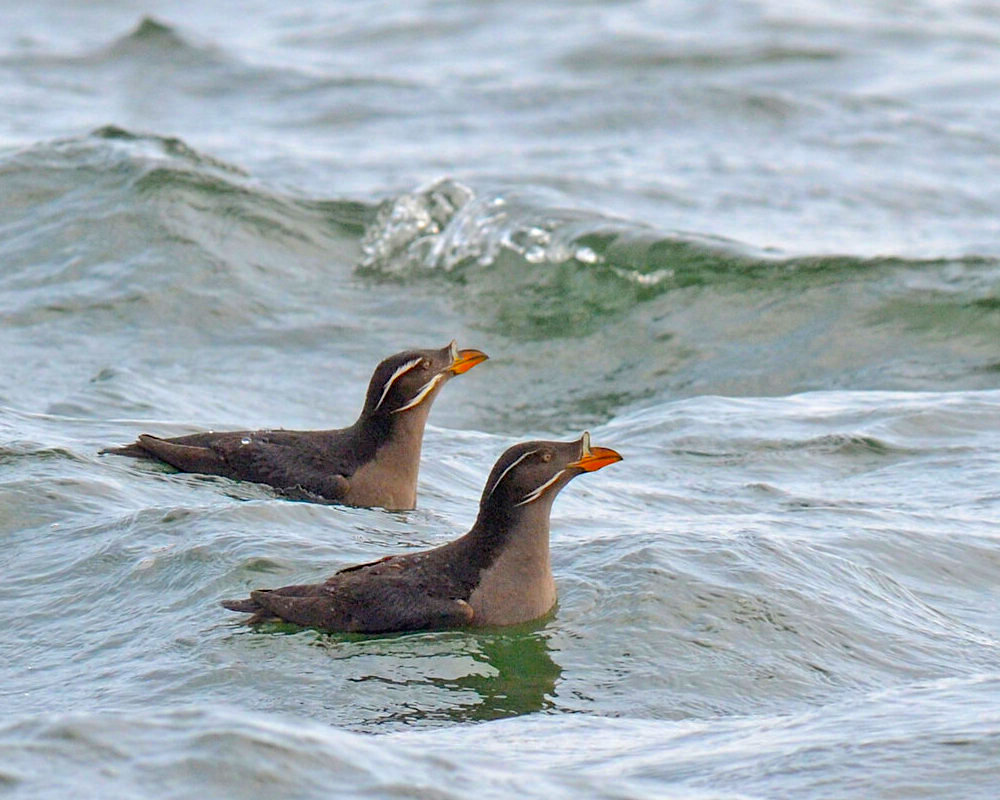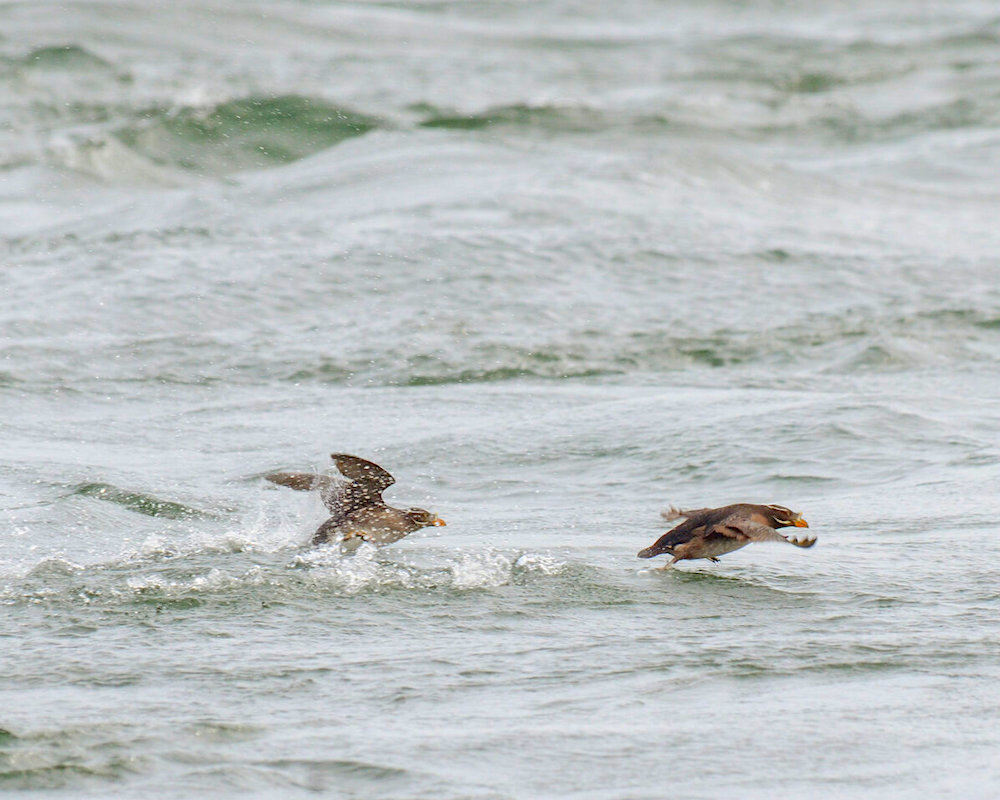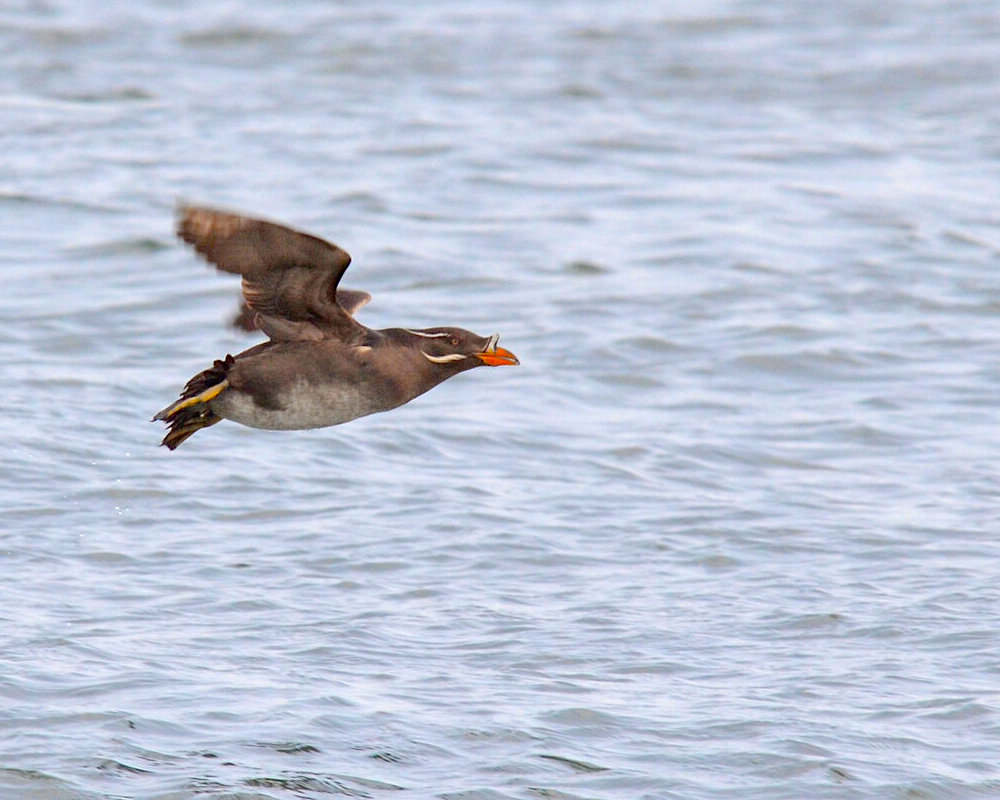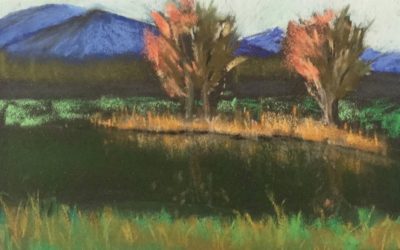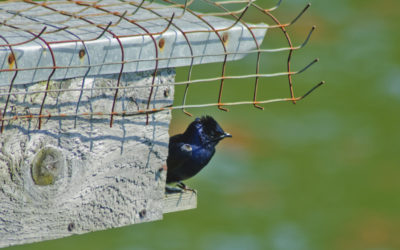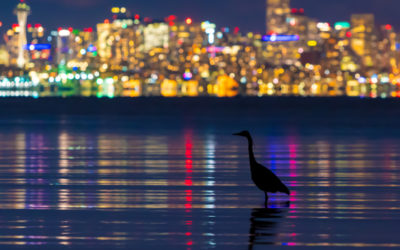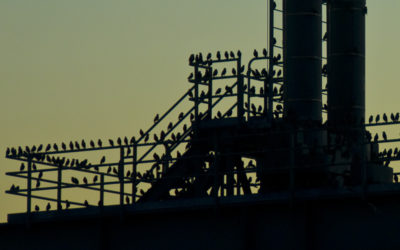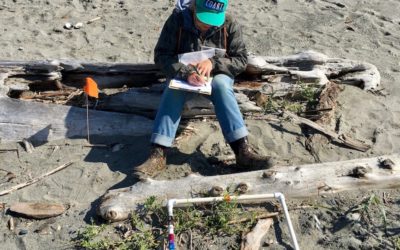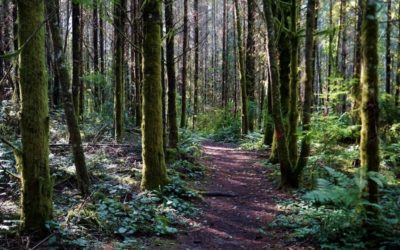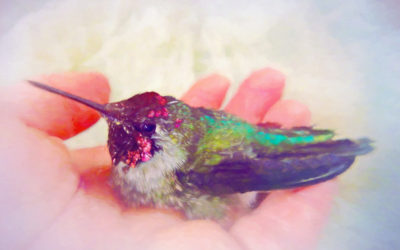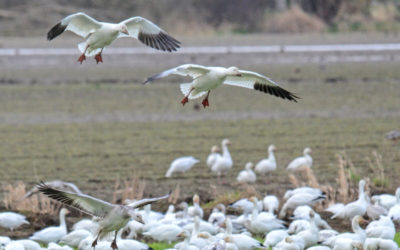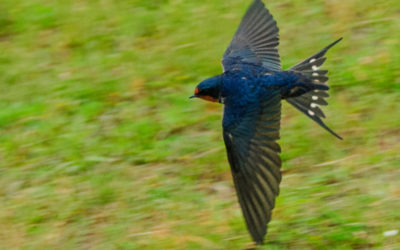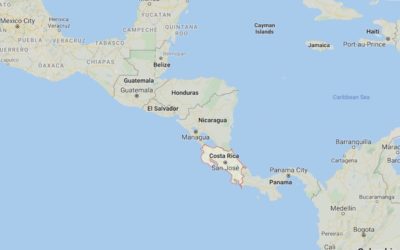SEABIRDS ARE COOL
by Julia Parrish, Winter 2019
Photo by Lee Tenneboe
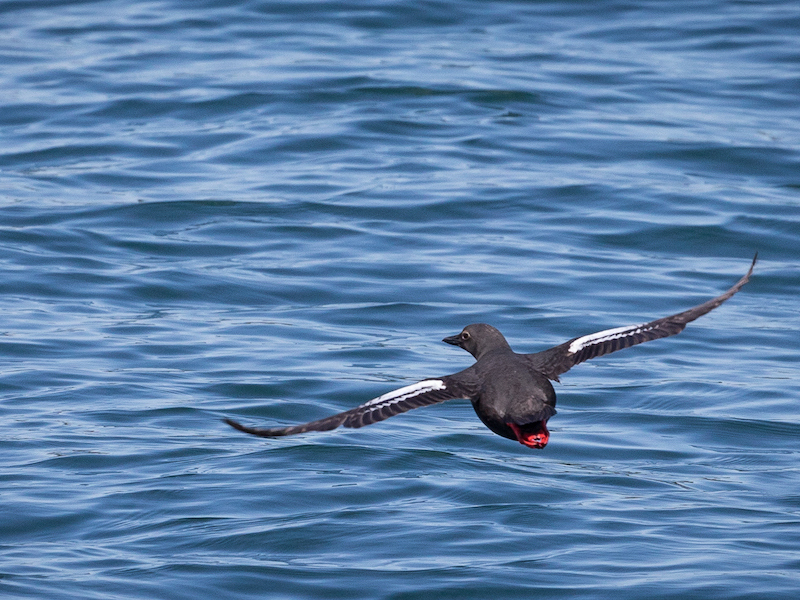
Photo by Lee Tenneboe
SEABIRDS ARE COOL
by Julia Parrish, Winter 2019
In Washington State, there is a bewildering abundance of seabirds.
The seabirds of the surf zone that always capture my imagination are in the Alcid family: murres, murrelets, guillemots, auklets and puffins. At their largest—less than a kilogram—they stand a little under a meter in height. Well, at least a murre with its neck stretched out does. The smallest ones, ancient murrelets, are basically fluffballs. The entire family is adapted to moving from air to water seamlessly. Unlike shearwaters that plunge-dive into the water and stroke down a few meters with their long wings pulled in, murres and their cousins can fly underwater as easily as in air. Murres and puffins have been pulled up in gill nets set on the floor of the coastal shelf—typically 50 to 200 meters deep. Even their bodies belie this predisposition to move among fluids. An Alcid is a football with wings—bill pointed out straight, scrunched in neck, short tail, feet perfectly pointed, shortish wings beating the air. No gliders in this family.
But in the water? Wow! That thing that just went by you at lightning speed while you were diving the San Juans, leaving nothing but a corkscrew trail of bubbles? That was a murre. That bird that just popped out of the ocean next to Destruction Island with its bill full of sandlance all tucked in crosswise? That was a tufted puffin. That bird with the quizzical white eyebrow and bright blue (think 1960s painted-on eyeshadow) feet—Cassin’s auklet. Those dark bodied, buff-chested birds you can spot around the Kingston ferry docks, the ones with an orange grooved bill sporting a white horn—rhinoceros auklets. And who wouldn’t love pigeon guillemots arrayed on the intertidal boulders below their breeding cliffs on Whidbey Island, displaying their bright red feet and mouths as they whistle their Gregorian tritone chants at each other.
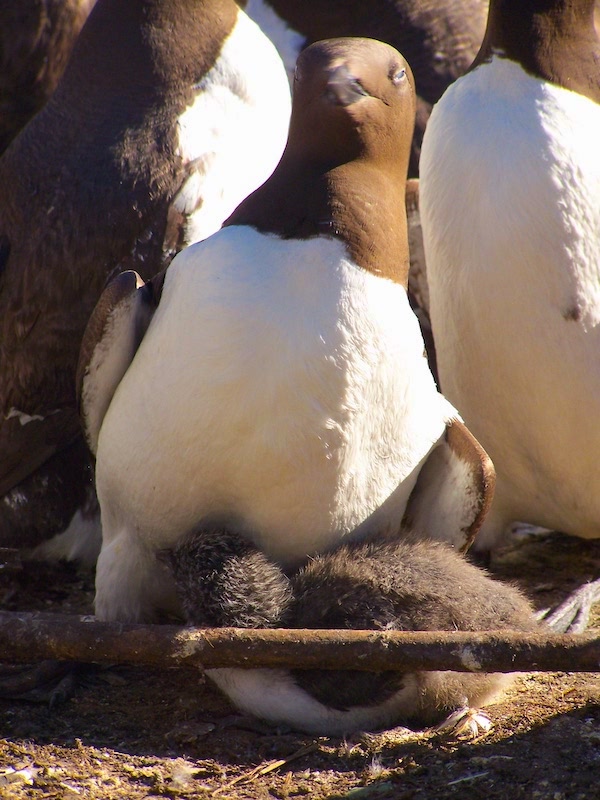
Murre and chick—Photo by Peter Hodum
Unlike songbirds that nest in abundance—several eggs per clutch, even multiple clutches per year—most seabirds, and definitely Alcids, are long-lived. Individuals can live beyond 20 years. They trade the “pump them out” strategy for the single long-cared-for egg and chick every year. When murre chicks fledge, at about a third of adult size, the male parent accompanies the chick to sea. Incredible that they—like bats in a cave—can recognize individual voices. So when the chick literally leaps off the cliff unable yet to fly, bouncing down the rocks into the intertidal below, Dad flies down and starts calling from the water. Like a new tennis ball—all fluff and bounce—the chick scrambles into the water, avoiding marauding gulls looking for an evening snack, and starts calling back: “cheep, cheep, CHEEP!” Off Cape Flattery, when the murres are fledging in August and September, you can hear these plaintive calls on calm nights. The bond is strong and Dad-chick pairs reunite to spend the next many weeks together until the fledgling is fully able to fish on its own.
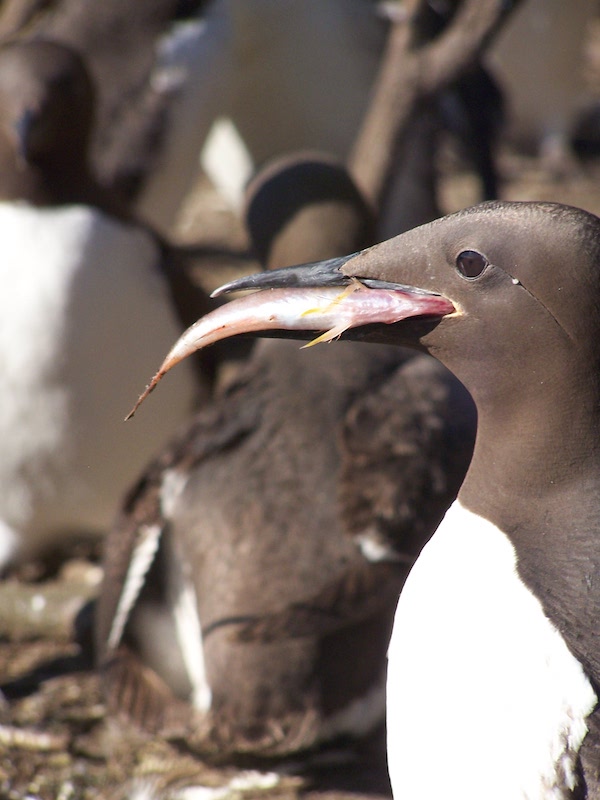
Murre eating a rockfish—Photo by Jane Dolliver
To me, Alcids are our Salish Sea canaries in a coal mine. As fish-eaters, they rely on the same bounty that Chinook and Coho do, and they can swim and feed anywhere a salmon can. Sitting almost atop the food chain, salmon and murres chow down on a feast of forage fish that are found in Salish Sea and outer coast waters. In fact, Salish Sea waters have a plethora of these species—Pacific herring, northern anchovy, sandlance, eulachon and their smelt relatives—all small enough for a murre or a puffin to take. And so the forces that shape the forage fish community—water quality, healthy spawning habitats, cool ocean water burping into the Salish Sea—these all affect whether Alcids get enough to eat and to feed their chicks.
[Editor’s note: Forage fish play a unique role in the food web of the Salish Sea. They depend on clean water and natural shorelines, and are susceptible to the cumulative impacts associated with shoreline development, e.g., vessel noise, ambient light, poor water quality, and shoreline hardening. According to Puget Sound Info, forage fish populations are actually declining.]
 See more about forage fish in Find Out More at the end of the article
See more about forage fish in Find Out More at the end of the article
Figuring out that puzzle—who is connected to what and which little adjustment of the picture can ripple out into a major change somewhere else—can keep a scientist busy, happy and increasingly worried, for a lifetime. In my case, I followed the path that many naturalists have, starting with the beauty of nature, wrapped by the connectedness of everything, literally wanting to turn over every rock on my study site—a murre colony on the outer coast—just to see what was there.
What I found was fascinating, a complex interplay of habitat, birds and people, the tendrils of which dictated the fate of the murres.

Murres on an outcropping—Photo by Kevin Mack
Although Murres spend most of their time at sea, only coming to land to breed on rocky cliff shores or islands, they are the densest-nesting birds in the world, with hundreds or maybe tens of thousands living shoulder-to-shoulder in groups that may stretch across a rocky outcropping. Loud! smelly! One advantage of this colonial nesting strategy is keeping neighboring predators at bay. No glaucous-winged gull with half a brain would dare to brave the phalanx of long, sharp murre bills pointing out towards the impending egg predator danger. Nope. A murre colony full of murres is impossible for an egg- or chick-predator to get into. But on my colony, another bird threatened. Bald eagles in slow recovery from years of egg-shell thinning, habitat loss, and hunting were on the rise. And the murres were no match for these rapacious birds.
An eagle in the colony means “Abandon!” especially if it is early in the season when most female murres haven’t yet laid an egg. Suddenly the early layers are all alone. Danger, Will Robinson! Better to give up the egg and try another year than face certain death at the talons of a raptor. That means a free lunch for the gulls. More eagles, more murre scares, more eggs eaten by gulls, until an entire nesting area could be wiped out for the season.
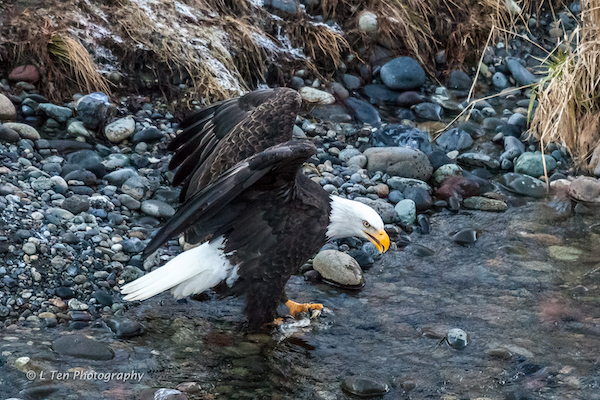
Bald eagle—Photo by Lee Tenneboe
Murre success and numbers of murres on the colony were going down. Then the murres started to adapt. They learned that when they nest back into the salmonberry thicket, the canopy of vines closes over them, protecting them from eagle attack. Even when they landed on the edge of the cliff, the eagles were literally too broad-shouldered to make it through the salmonberry to where the murres were safely—albeit shivering with fear—on their eggs. Eggs kept and hatched; colony saved!
However, two and a half months of murres nesting shoulder-to-shoulder means a heck of a lot of fertilizer squirted out and a heck of a lot of bird feet padding back and forth compressing the forest soil. The salmonberry began to die back, and the soil eroded away in the winter storms, opening up newly-exposed rock face. Suddenly eagles could access their prey again.
These cycles: eagle-gull-murre; murre-salmonberry-eagle are just two of the many that weave together to tell the ecology of the species and the place. In this case, eagle conservation (a good thing!) and gull use of human habitats (not so good) allowed both of those populations to expand, perhaps beyond what murres had recently experienced, and certainly beyond what they could sustain, at least in the short-term. Murre populations along the Pacific Northwest tend to fluctuate, in part because of this cattywhompus cycle.
 See more about relationships between murres and eagles in Find Out More at the end of this article.
See more about relationships between murres and eagles in Find Out More at the end of this article.
But of course that’s not the end of the story; it never is in ecology. Connections mean there are always new forces pushing and pulling. As conditions shift, murres, and their puffin and auklet cousins, are responding by slowly, slowly expanding their ranges, usually to the north. In California, new rocky outcroppings have been colonized. In Alaska, more rhinoceros auklets have been seen recently. If we give them space, they will come. If the ocean provides the forage fish, they will stay. Spotting Alcids, whether from the San Juans ferry or from Dungeness Spit, from a salmon-fishing boat, the Seattle seawall, or the beach on Whidbey Island, these are all amazing experiences I don’t want to stop having.
Rhinoceros auklets—Photos by Catherine Whalen
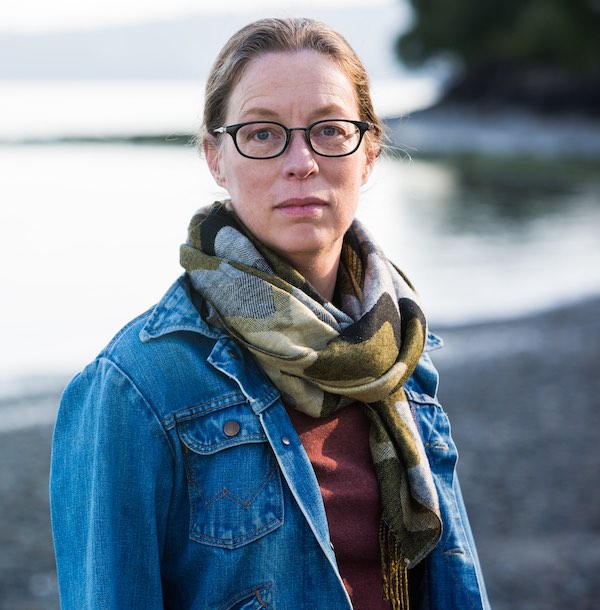
Julia K. Parrish is the Lowell A. and Frankie L. Wakefield Professor of Ocean Fishery Sciences at the University of Washington. A marine biologist, a conservation biologist, and a specialist in citizen science, Julia has conducted field investigations of marine birds and their habitats for more than 30 years.
In November 2019, Julia was named an AAAS Fellow by the American Association for the Advancement of Science. Fellows are chosen by their peers for “scientifically or socially distinguished efforts to advance science or its applications.” Julia was elected for her work in marine ecology.
Table of Contents, Issue #6, Winter 2019
Birds of Bufflehead Pond
by Adelia Ritchie, Winter 2019Painting by Adelia Ritchieby Adelia Ritchie, Winter 2019 Such big ideas we had when we first set out to inhabit Bufflehead Pond Farm! The place had not been properly tended for years and the local ecology (mostly blackberries and...
Purple Martins
by Gene Bullock, Winter 2019Photo by John F. WilliamsPhoto by John F. Williamsby Gene Bullock, Winter 2019 Native Americans learned long ago that if they hung hollow gourds around their villages, they could attract Martins to nest in them. The birds repaid them by...
Great Blue Heron
by Nancy Sefton, Winter 2019Photo by Philip HutchersonPhoto by Philip Hutchersonby Nancy Sefton, Winter 2019 As I floated in my kayak, I spotted a great blue heron perched on a mass of partially submerged roots. Suddenly it stabbed the water and came up with a small...
Poems-6
Winter 2019Winter 2019 Haiku by Nancy Rekow One heron standing.Mist hangs low in the valley.I will write to you.Painting by Kathleen Faulknerby Nancy TaylorIn Beacon Hill Park, Victoria B.C. I watch a bald eaglelight...
Citizen Science
by Todd Ramsey, Winter 2019Photo by Eric Wagner, COASST staffPhoto by Eric Wagner, COASST staffby Todd Ramsey, Winter 2019 It all started out so innocently. We just wanted to pick up trash on the beach after a storm. Soon after that we discovered COASST.org (Coastal...
Foto Tour 2
Showcase of Participant Photos North Kitsap Heritage Park from September 18, 2019 Showcase of Participant Photos North Kitsap Heritage Park from September 18, 2019 On September 18, 2019, WSU Extension in Kitsap County hosted a Forest Foto Expedition led by John F....
Should I Stay?
by Sharon Pegany, Winter 2019Artwork by Catherine WhalenArtwork by Catherine Whalenby Sharon Pegany, Winter 2019 turn of time rustle of feather echoing songs of beak and bill listen afresh to the voices among usWinter may be a quiet season in the Salish Sea region,...
The Russians Are Coming
by Paul Pegany, Winter 2019Photo by Catherine WhalenPhoto by Catherine Whalenby Paul Pegany, Winter 2019 The Russians are indeed coming! They are winged, white, and ready to spend their winter along the shores of the Salish Sea in northwest Washington. As the rain...
Barn Swallow
Nature's Pest Control by Adelia Ritchie, Winter 2019 Photos by John F. Williams except where notedNature's Pest Control by Adelia Ritchie, Winter 2019 Photos by John F. Williams except where notedClose cousin of the purple martin is our hard-working summertime...
Editorial-6
by Adelia Ritchie, Winter 2019by Adelia Ritchie, Winter 2019 On vacation in Costa Rica recently, I walked the city of San José one morning and visited a famous museum of pre-Colombian civilization, back when indigenous tribes lived in harmony with nature and as a...
PLEASE HELP SUPPORT
SALISH MAGAZINE
DONATE
Salish Magazine contains no advertising and is free. Your donation is one big way you can help us inspire people with stories about things that they can see outdoors in our Salish Sea region.
We also don't advertise Salish Magazine, so please spread the word of this online resource to your friends and colleagues.
Thanks so much for your interest and your support.
We also don't advertise Salish Magazine, so please spread the word of this online resource to your friends and colleagues.
Thanks so much for your interest and your support.
FIND OUT MORE
There are several articles related to forage fish in the Encyclopedia of Puget Sound,. For example: https://www.eopugetsound.org/magazine/armoring-sanjuans
Some aspects of the decline of forage fish are described in the Puget Sound Partnership’s Vital Signs: https://vitalsigns.pugetsoundinfo.wa.gov/VitalSign/Detail/20
You can read more about the relationships between eagles and murres at: https://www.fws.gov/refuge/Cape_Meares/wildlife_and_habitat/murres_and_eagles.html



